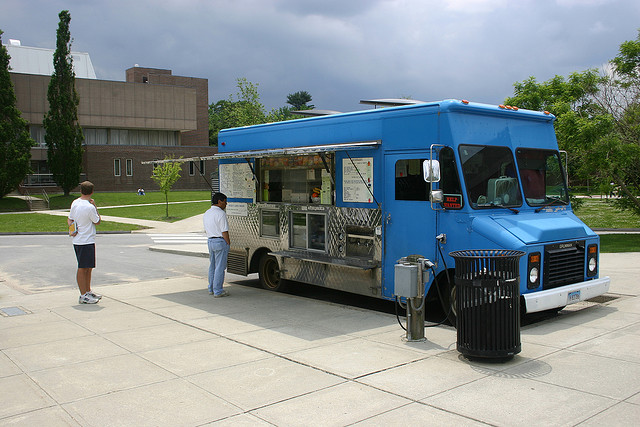
New P3 trend involves restaurants, food service vendors, universities, school districts

Photo by grendelkhan is licensed under CC BY 2.0
Sweeping national trends rarely originate in public school cafeterias or college dining halls. But, at least one did!
On campuses nationwide, student lunches in noisy dining areas are becoming a thing of the past. Food trucks are now the new rage.
Campuses that offer food service to students, either prepared in-house or through contracts with professional on-campus dining services, face a daily dilemma. The food must not only meet strict nutritional standards, but it must also appeal to the discerning and diverse preferences of students.
Because that is not an easy task, a growing number of schools have adopted a highly successful private-sector food trend. Food trucks are rolling onto educational campuses throughout the country!
Students want to be able to choose between Asian, Indian, Mexican, Mediterranean or vegetarian food offerings. That’s almost impossible in a traditional cafeteria line. But, it makes food trucks an exceptionally attractive option.
In 2007, only about a dozen colleges had food trucks. By 2014, that number had increased to about 100 and the trend continues to grow. The University of Texas at Dallas initially made the decision to allow food truck offerings because it seemed wise to mirror the heritage and culture of a growing segment of its student population – the more than 5,500 international students from 100 countries.
Many food and nutrition requirements and restrictions on public education campuses are mandated so there are no “junk food” trucks. In some cases, food truck menus are created from input by the school dietician. They are under contract to offer healthy, and tasty, food alternatives.
Officials of major national food service companies that manage food services for universities have historically provided revenue to the host campus. And, because the campuses have come to rely on that revenue, many have initiated their own food truck services. Others contract with restaurants and/or food service providers and simply require them to share a portion of the revenues.
In general, these types of engagements become public-private partnerships (P3s). The public entity provides the space and the students who create the demand. A private partner invests in the food truck assets and then agrees to manage and operate the service. Revenues are collected and split on an agreed amount set by the partners.
Competition among universities for students is fierce and every amenity counts! The food trucks offer mobility and diversity that students prefer. They also can be moved to remote areas of the university and to outdoor sporting and entertainment events.
Among the earliest hosts to campus food trucks were the University of Washington and the University of California-Irvine, both of which launched their own food trucks five years ago. And, one private-sector food service company currently boasts having its food trucks on two-dozen campuses nationwide. It would not be easy to find a major university that is not at least considering this option.
Public schools (K-12) have also become hot spots for food trucks. The Pflugerville Independent School District became the first school district in Texas to roll out new dining opportunities afforded by a food truck.
Another Texas school district will add food truck service to its dining options next year. Officials are hopeful that more diversity in the truck menu and better food will encourage more students to purchase school lunches.
Food trucks on campuses look like they’re here to stay. This creates a new marketplace and new opportunities for P3s, and companies that serve food should monitor the trend carefully.
